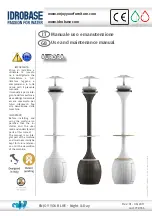
FUNCTIONAL TESTS
FUNCTIONAL CHECKS
(AFTER EACH USE AND MONTHLY)
1. Check that the regulator works properly. The regulator
outlet should be sanitized before and after testing.
a. Check that the cylinder valve and buttons are
closed and that the system is not pressurized.
b. Gently inhale through the regulator outlet and hold
your breath for about 10 seconds. If the negative
pressure is maintained, there is no leakage.
c. Gently exhale through the regulator outlet for about
10 seconds. If the positive pressure is maintained,
there is no leakage.
d. Do not use the apparatus if airflow through the reg-
ulator is detected in either test. Return the regulator
to a certified repairperson.
2. Inspect the buttons and bypass valve.
a. With the regulator pressurized, operate each valve
to be sure it operates. Venting of pressure relief
valves (or a continuing flow of air through the regu-
lator when the user is not inhaling) indicates that the
regulator needs to be repaired.
b. Listen to the regulator. Any unusual sounds such as
whistling, chattering, clicking, or rattling mean that
the regulator should be checked further.
c. If any of these symptoms occur, the apparatus must
be removed from service. Return the regulator to a
certified repairperson.
3. Whistle Audible Alarm
a. Check that the function of the whistle audible warn-
ing device be checked by observing the regulator
gauge pressure at which the alarms sounds.
Perform this test with a minimum cylinder pressure
of 1,200 psig for the Low Pressure Air Mask, and
2,000 psig for the High Pressure Air Mask.
b. Pressurize the system by opening the cylinder valve
for a moment, then close it. The whistle must sound
indicating it is functioning.
c. Open bypass slowly.
d. Watch the drop in pressure on the shoulder gauge
and the point at which the whistle must begin to
sound. Nominal gauge readings at which the whistle
starts to sound are listed below.
550 psig approximately (low pressure system)
1125 psig approximately (high pressure system)
e. The whistle must continue until the air pressure is
approximately 200 psig or less. If the whistle does
not function properly, the apparatus must be
removed from service.
Do not disconnect the regulator coupling nut when
pressure is shown on the regulator gauge. Release all
pressure from the regulator by opening the bypass
valve. Removing the coupling nut with the regulator
pressurized may result in serious personal injury,
death, or damage to equipment.
f. Open the bypass valve slowly to release trapped air.
Close bypass valve.
g. Unscrew the regulator coupling nut from the cylin-
der valve. It is hand-tight and should not require
tools.
h. Inspect the coupling nut for thread damage. Also be
sure there is an O-ring and that it is not damaged.
i. Replace the O-ring if it is damaged.
19
TAL 5010 (L) Rev. 3 - 10037469
WARNING
Summary of Contents for AirHawk MMR
Page 4: ...NOTES 4 TAL 5010 L Rev 3 10037469...
Page 14: ...NOTES 14 TAL 5010 L Rev 3 10037469...
Page 16: ...NOTES 16 TAL 5010 L Rev 3 10037469...
Page 18: ...NOTES 18 TAL 5010 L Rev 3 10037469...
Page 21: ...NOTES 21 TAL 5010 L Rev 3 10037469...
Page 22: ...NOTES 22 TAL 5010 L Rev 3 10037469...
Page 24: ......


































